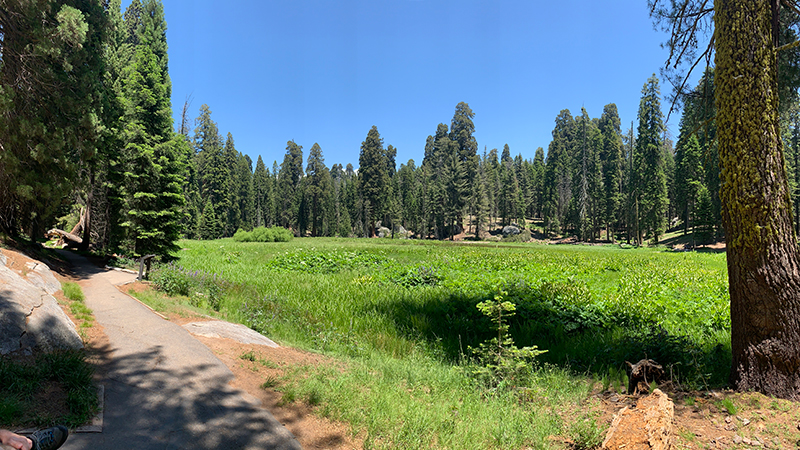
The Giant Forest is the second largest giant sequoia grove in the world, home to the largest tree on the planet: the General Sherman Tree, and where you’ll find the easy, flat Big Trees Trail. It is also the most popular and impacted part of Sequoia National Park.
On our first day in the park, we were unable to find any parking near Giant Forest, so we saved it for our second day and spent much of the day exploring the area. We checked out the views at Beetle Rock, climbed to the summit of Moro Rock, walked through Tunnel Log, and meandered along the Crescent Meadow Trail to Tharp’s Log, and strolled along the Big Trees Trail — all before even visiting the Giant Forest Museum, which is totally backward of how we normally do thing!
Big Trees Trail is an accessible, fairly flat, 1.3 loop trail that circles Round Meadow in Giant Forest.
It features trail side exhibit panels that interpret the natural history and ecology of the sequoia grove and is VERY busy from May through November.
The short trail from Giant Forest Museum to the Big Trees Trailhead passes a former gas station from the era when Giant Forest Museum was the Giant Forest Market. Big signs at the trailhead point in either direction of the loop trail.
We set out on Big Trees Trail to the right, to first walk along the edge of Round Meadow past a cluster of massive sequoias, fallen logs, and the lush forest floor full of ferns. We then crossed a small wood bridge over a little creek and went deeper into the forest to the biggest sequoia trees.
Rounds Meadow
Round Meadow was privately owned and surrounded by cabins when Sequoia National Park was established in 1890. Donations from the National Geographic Society funded the purchase of Round Meadow in 1916 and it became part of the national park. In the 1970s, proof of human development was removed to better protect the giant sequoias and return the area to its natural state.
Know Before You Go
- Big Trees Trail is an accessible, fairly flat, 1.3 mile, loop trail with only 50 feet of elevation change that circles Round Meadow. Accessible parking is available at the trailhead.
- Sequoia National Park and Kings Canyon National Park are basically treated as the same park — even the National Park Service combined both parks into one website.
- The parks are open 24 hours a day, 365 days a year. Occasionally, winter storms will close roads leading into the parks until they can be plowed.
- Admission fees are good for seven days and both parks. They are $35.00/vehicle, $30.00/motorcycle, $20.00/individual entry on foot or bicycle, $15.00/person for a non-commercial group.
- There are five free admission days: the birthday of Martin Luther King, Jr., the first day of National Park Week, the National Park Service Birthday, National Public Lands Day, and Veterans Day.
- Weather varies a lot by season and elevation, which ranges from 1,370 feet to 14,494 feet. Bring layers and be prepared!
- Cell service is not available in most areas. You may get service in Grant Grove and at the Foothills Visitor Center. WiFi is available at the Foothills Visitor Center, the Grant Grove Visitor Center, and in the lobby of Wuksachi Lodge.
- Pets are not permitted on any trails at Sequoia and Kings Canyon National Parks. In campgrounds and picnic areas, pets must be kept on a leash of no more than six feet at all times.







